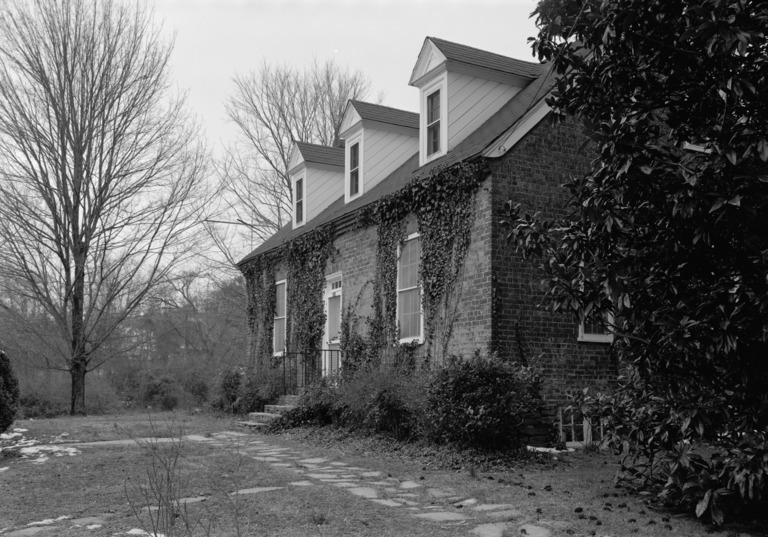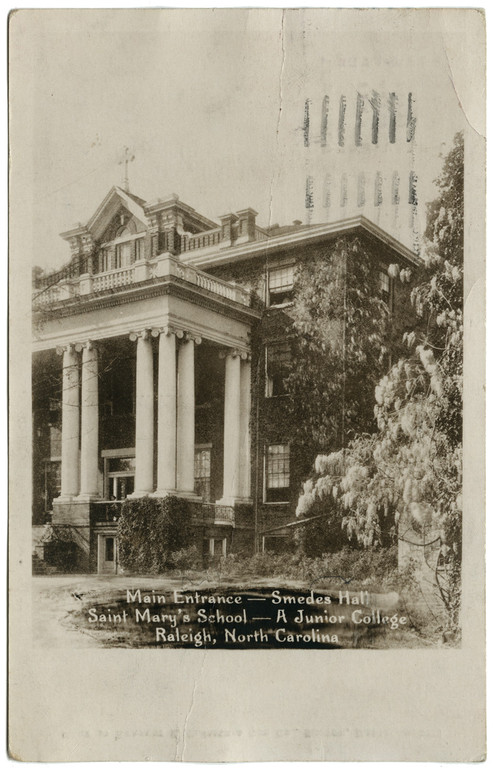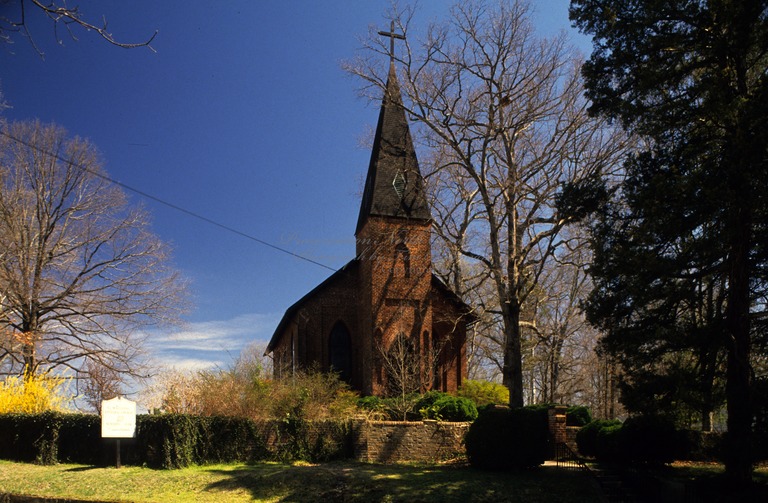Hancock, Samuel (1784-1848)
Birthplace:
Orange County, North Carolina, USA
Residences:
- Hillsborough, North Carolina
Trades:
- Brickmaker
- Brickmason
Building Types:
Styles & Forms:
Federal; Gothic Revival; Greek Revival
Samuel Hancock (1784-April 11, 1848), a brickmason and brickmaker in Hillsborough during the early 19th century, served as mentor to Hillsborough’s distinguished brick builder John Berry and worked with Berry for several years.
The Hancock name first appears in Orange County records in the 1780s. Samuel Hancock, whose father may have been Henry Hancock, could neither read nor write. His wife, Susan or Susannah Richards Hancock (1781-October 6, 1864), appears to have been distantly related to Rhody Berry and her son John. In 1811 the Hancocks were living on Lot 72 in Hillsborough, diagonally across West Queen Street from Mrs. Berry’s Lot 54, and strong local tradition has it that in about 1814 the kindly Samuel Hancock assisted young John Berry in the construction of the Berry family’s brick house (Berry House) at 208 West Queen Street. In 1815 Hancock also gave the 17-year-old Berry his first chance at a paying job as a bricklayer, constructing the Hillsborough Presbyterian Church on the old town cemetery lot, Lot 98. These projects began an association with the Berrys that ended only with Susan R. Hancock’s death in 1864.
Hancock, like Berry, became involved in the affairs of the new church. Susan Hancock joined the church on October 27, 1816, and Samuel Hancock on November 17, 1821. Samuel also rented a pew in the church and contributed toward the pastor’s salary and a bell for the church.
In 1819 Hancock, assisted by a $50 loan from Dr. James Webb, bought lots near the Eno River to establish a brickyard, which became known as the Webb-Hancock brickyard. Although Hancock worked regularly at his trade, he frequently found himself in financial difficulties. Dr. Webb’s papers include many notations indicating Hancock’s financial dealings as well as many of his small masonry jobs in Hillsborough, which included building brick chimneys, steps, and underpinnings. In 1834, during a period of economic troubles for many North Carolinians, Hancock went bankrupt, after which he struggled for the rest of his life to repay Dr. Webb, who bought the Hancocks’ house and lot, their furniture, and their slave Abram, and rented them all back to Hancock for $1.00 per year. Webb also paid the tuition fees for the Hancock children (Susan and John) and in effect supported the family.
In contrast to his handling of financial matters, Hancock’s competence at his trade was never questioned. The rising John Berry employed him regularly as his masonry associate and overseer for projects.
In 1824 the Person County commissioners employed Hancock as one of a trio—Hancock, Berry, and carpenter John A. Faucett—to build a new Person County Courthouse. This was a handsome brick edifice with classical detailing, for which detailed specifications still survive. Later on, such large contracts typically went directly to Berry. With Berry, Hancock accomplished the fine brickwork at numerous houses in Hillsborough as well as notable brick public buildings and churches in Hillsborough, Yanceyville, Salisbury, and Wake Forest.
In 1835 and 1836, two Raleigh contracts came to Hancock on his own, who was then working with John Berry on buildings at Wake Forest College in Wake Forest.
Both of Hancock’s Raleigh projects were connected with banker and planter Duncan Cameron. Hancock agreed to furnish brick and perhaps to supervising laying some of it for the new 4-story Main Building (later Smedes Hall) at the Episcopal School of North Carolina (now St. Mary’s School) in Raleigh. Records of the school building committee noted on July 1, 1835, “one hundred dollars advanced to Samuel Handcock [sic] on his contract for furnishing brick,” and documents in the William Laurence Saunders Papers include payments to Hancock for various workmen on the job. Duncan Cameron, chief sponsor of the school, was also building a house for himself (Duncan Cameron House) across Hillsborough Street from the school. Cameron Family Papers include a bill in 1836 for Hancock’s work totaling $240.50: chimneys, pillars, brick foundations, rock walls, kitchen floor paving, etc.
In 1842 Hancock’s friend and associate Dr. Webb himself went bankrupt, and the bankruptcy papers noted that the Webb-Hancock brickyard had been operated by the two men “as partners.” The facility continued to produce brick at intervals, but Hancock’s involvement in the operation tapered off after that time. After a few years of deteriorating health, he died at age 64 in 1848. His friend Webb died in 1855. John Berry had previously purchased the Hancock home, and his will written in 1859 enabled Susan Hancock to continue living there until her death in 1864.
- Cameron Family Papers, Southern Historical Collection, Wilson Library, University of North Carolina at Chapel Hill, Chapel Hill, North Carolina.
- Mary Claire Engstrom Collection, Southern Historical Collection, Wilson Library, University of North Carolina at Chapel Hill, Chapel Hill, North Carolina.
- Episcopal School of North Carolina Papers, North Carolina State Archives, Raleigh, North Carolina.
- Hillsborough Recorder, Apr. 19, 1848; Oct. 12, 1864.
- Francis Nash Collection, Private Collections, North Carolina State Archives, Raleigh, North Carolina.
- Orange County Deeds, Wills, Estates Papers, Court Records, and Marriage Bonds, Orange County Records, North Carolina State Archives, Raleigh, North Carolina.
- Person County Building Commissioners Records, Person County Records, North Carolina State Archives, Raleigh, North Carolina.
- William L. Saunders Papers, Southern Historical Collection, Wilson Library, University of North Carolina at Chapel Hill, Chapel Hill, North Carolina.
- James Webb Papers, Southern Historical Collection, Wilson Library, University of North Carolina at Chapel Hill, Chapel Hill, North Carolina.
Berry House
Contributors:John Berry, attributed brickmason; Samuel Hancock, attributed brickmasonDates:Ca. 1814
Location:Hillsborough, Orange CountyStreet Address:208 W. Queen St., Hillsborough, NC
Status:Standing
Type:Residential
Images Published In:Lucile Noel Dula, Pelican Guide to Hillsborough (1979).
Note:The 1 1/2-story dwelling, one of the earliest brick buildings surviving in Hillsborough, shows less skilled brickwork than buildings done during Berry’s adulthood. Tradition says that Berry helped Hancock construct the house for Berry and his mother.
Burnside
Contributors:Dates:1834-1835
Location:Hillsborough, Orange CountyStreet Address:Opposite east end of Margaret Ln., Hillsborough, NC
Status:Standing
Type:Residential
Images Published In:Lucile Noel Dula, Pelican Guide to Hillsborough (1979).
Note:For Paul Cameron of Burnside, Berry evidently built the brick chimneys, a brick kitchen, and a large brick ice pit, which still survives. Jack Dewey of New Bern accomplished much of the carpentry.
Duncan Cameron House
Contributors:Jack Dewey, carpenter; William Drummond, builder; Samuel Hancock, brickmason; Thomas A. Waitt, builderDates:1835
Location:Raleigh, Wake CountyStreet Address:Hillsborough St., Raleigh, NC
Status:No longer standing
Type:Residential
Images Published In:Elizabeth C. Waugh, North Carolina’s Capital, Raleigh (1967).
Note:The house built in 1835 for Duncan Cameron was remodeled in 1901 for his grandson Bennehan Cameron, who added a large portico and additional rooms. It stood on the south side of Hillsborough Street opposite St. Mary’s School. Portions of its interior woodwork are said to have been reused in a house in Raleigh’s Hayes Barton neighborhood.
Frederick Nash House
Contributors:Variant Name(s):Nash and Kollock School
Dates:1819
Location:Hillsborough, Orange CountyStreet Address:Margaret Lane, Hillsborough, NC
Status:Standing
Type:Residential
Hillsborough Academy
Contributors:Variant Name(s):Caldwell Institute
Dates:Ca. 1822
Location:Hillsborough, Orange CountyStreet Address:NW corner of N. Wake St. and W. Orange St., Hillsborough, NC
Status:No longer standing
Type:Educational
Hillsborough Presbyterian Church
Contributors:John Berry, attributed brickmason; Samuel Hancock, attributed brickmasonDates:1815-1816
Location:Hillsborough, Orange CountyStreet Address:102 W. Tryon St., Hillsborough, NC
Status:Altered
Type:Religious
Images Published In:Lucile Noel Dula, Pelican Guide to Hillsborough (1979).
Note:John Berry and Samuel Hancock were pew holders at Hillsborough Presbyterian Church. A memorial plaque to Berry was placed in the church by his grandchildren in 1948.
Person County Courthouse
Contributors:Dates:1825-1826
Location:Roxboro, Person CountyStreet Address:Roxboro, NC
Status:No longer standing
Type:Public
Note:Person County records (North Carolina State Archives, Raleigh) contain detailed specifications for the Person County Courthouse, defining what was expected in a well-built but not extravagant brick building, from the thickness of the brick walls (3 bricks thick at the bottom, tapering up to 2 bricks) to the paint colors (white trim, mahogany colored shutters and doors, slate colored roof, and “sky blue” ceilings). Other notable features included a hip roof, steps and sills of hewed stone, and “gambon” arches over the doors and windows. (The meaning of gambon is unclear.)
Smedes Hall
Contributors:William Drummond, builder (1835-1837); Samuel Hancock, brickmaker (1835-1837); Charles E. Hartge, architect (1909); Thomas A. Waitt, builder (1835-1837)Variant Name(s):Main Building
Dates:1835-1837; 1909 [addition]
Location:Raleigh, Wake CountyStreet Address:Hillsborough St. at St. Mary’s St., St. Mary’s School, Raleigh, NC
Status:Standing
Type:Educational
Images Published In:Linda L. Harris and Mary Ann Lee, An Architectural and Historical Inventory of Raleigh, North Carolina (1978).
Elizabeth C. Waugh, North Carolina’s Capital, Raleigh (1967).Note:The illustration shows Smedes Hall as remodeled by Charles E. Hartge.
St. Luke's Episcopal Church
Contributors:John Berry, builder; Samuel Hancock, probable builderDates:1828
Location:Salisbury, Rowan CountyStreet Address:N. Main St., Salisbury, NC
Status:Altered
Type:Religious
Note:Local tradition credited the design of St. Luke’s to Episcopal cleric Francis Lister Hawks, as was also the case with St. Matthew’s in Hillsborough.
St. Matthew's Episcopal Church
Contributors:Dates:1825-1826
Location:Hillsborough, Orange CountyStreet Address:St. Mary’s Rd., Hillsborough, NC
Status:Standing
Type:Religious
Images Published In:Catherine W. Bishir, North Carolina Architecture (1990).
Catherine W. Bishir and Michael T. Southern, A Guide to the Historic Architecture of Piedmont North Carolina (2003).
Frances Benjamin Johnston and Thomas Tileston Waterman, The Early Architecture of North Carolina (1941).
C. Ford Peatross, William Nichols, Architect (1979).Note:Local tradition credited the design of St. Matthew’s to cleric Francis Lister Hawks; there is evidence, however, that William Nichols took a role in the design of the modest Gothic Revival brick church.
Twin Chimneys
Contributors:John Berry, brickmason; Samuel Hancock, attributed brickmasonDates:1810s [renovation]
Location:Hillsborough, Orange CountyStreet Address:168 W. King St., Hillsborough, NC
Status:Standing
Type:Residential
Images Published In:Lucile Noel Dula, Pelican Guide to Hillsborough (1979).



